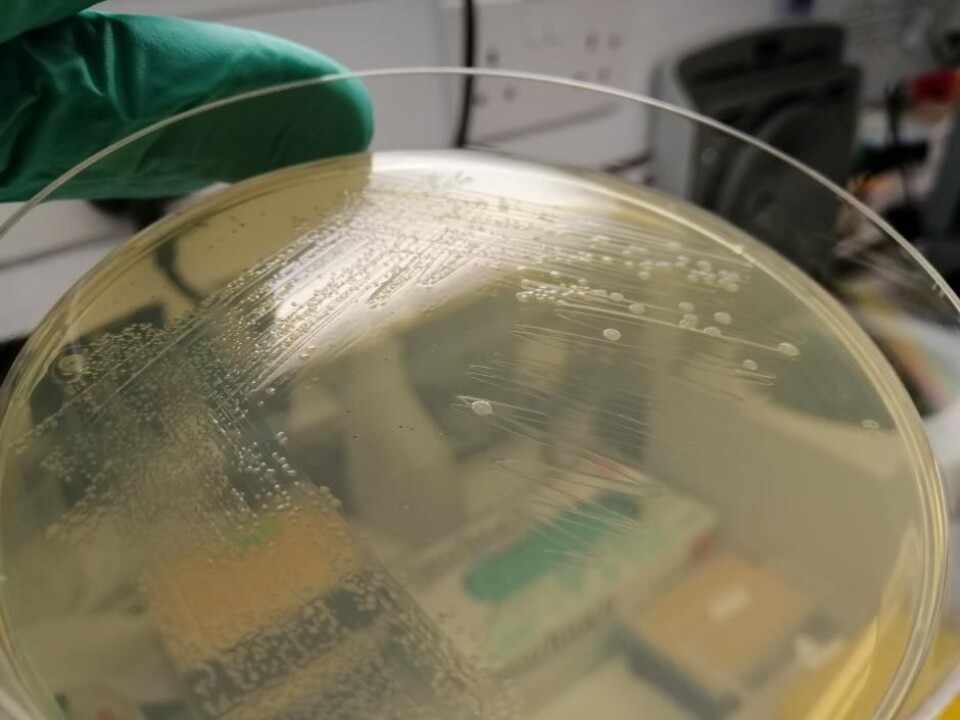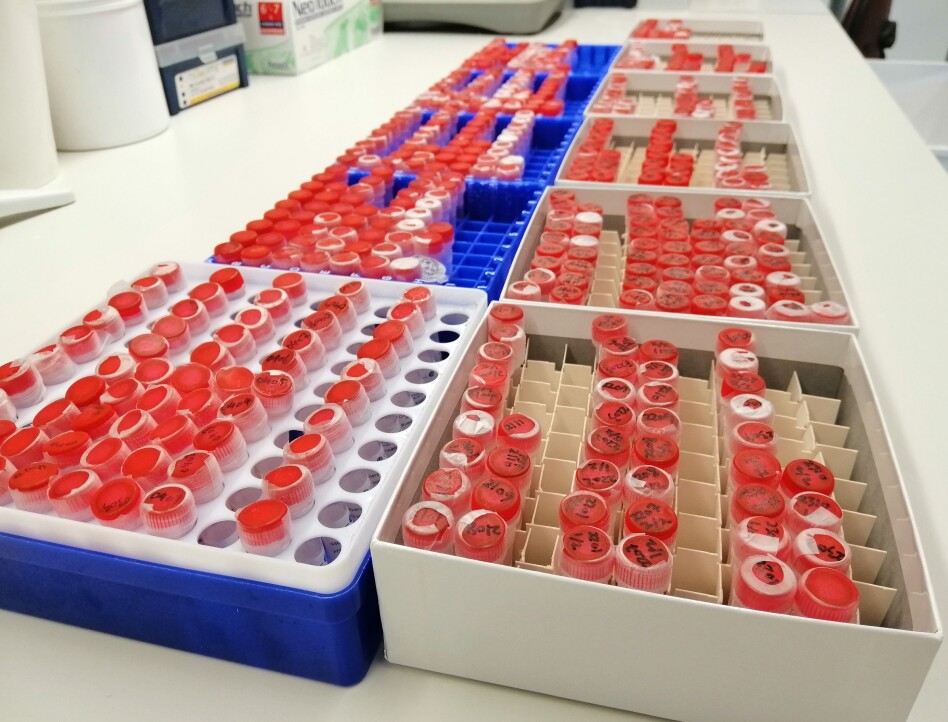Researchers' Zone:

After four billion years, the code of life has begun to shrink
The genetic code is billions of years old and contains the recipe for all life. Now scientists have managed to change it.
All living organisms contain genetic information in the form of a DNA code – this is old news to most people by now. But only few are aware that the genetic code is near-universal and that it is read in the same way in almost all life on Earth!
At least that was the case until this spring, where a life form with a slightly different genetic code sprouted. The little bacterium appeared in a laboratory in the English city Cambridge, bringing joy and celebration to us researchers involved.
The perspectives in such a genetic outsider are broad and stretch from biosafety to development of new enzymes. But more importantly, it demonstrates that it is possible to design and construct whole genomes, and thereby tailor microorganisms.
Since our bacterium belongs to the species Eschericia coli – a bacterium that typically lives in the intestine of humans and animals – we named it E. coli Syn61.
First, we will take a look at the genome.
The near-universal code
Every organism has a genome that carries the genetic information from generation to generation. This is the recipe for life; it instructs the cell on how and when to produce all its proteins. While the genome holds the information, the proteins (for example enzymes) are the workers that carry out most functions in the cell.
The genome consists of DNA built of the four bases adenine, cytosine, guanine, and thymine. When the cell reads the DNA, it decodes three bases at a time. Thus, the DNA code contains 4x4x4=64 combinations, named codons.
These codons are coding for the 20 amino acids, which the cell then puts together to form long amino acid chains, known as proteins. If we compare the genetic code to our written language, then the DNA code is an alphabet with 64 letters that describe 20 different sounds.
It is nothing less than astonishing that almost all life in our biosphere – from bacteria to Brussels sprouts and humans – interpret the genetic code in the exact same way.
I write almost all life because out of the 1.3 million known species on Earth, there is about a dozen of microorganisms that decode 1-2 codons slightly different. But that is all – the genetic code is near-universal.
Even though this is tremendously fascinating, the explanation is, however, simple: Decoding the genetic information is the most vital function in the cell and a necessity for evolution. As soon as the code had been established in the primordial cell, it became a fundamental part of developing life. That is why the code has barely changed.
A simpler life
Back to the 64 codons. 61 of them encode the 20 amino acids, while the remaining three codons signal a stop for protein synthesis, like a punctuation mark. With this excess of codons there are clearly more than necessary, so several synonymous codons encode the same amino acid.
This is analogous to our written language, where the sound of 's' can be written as both S and Z. It is therefore not an exotic idea to compress the genetic code in the same way that we could replace all Z's with S's in written language. However, until recently it was unclear if an organism can live with a compressed genetic code, or if important information would be lost.

American scientists made it some of the way
In 2013 American scientists managed for the first time to remove one codon from an entire genome. They removed the most rare codon in E. coli, which is used about 300 times throughout the genome. With so relatively few instances, it was possible to replace them all one by one in the living bacterium.
However, this approach cannot be used directly to simplify the genetic code further, as the remaining codons are much more abundant. It would therefore take a very long time to replace them one at a time. So we needed a new strategy to be able to compress the genetic further.
400 pieces of DNA directly from the factory
The solution is simple, at least theoretically: Instead of making small changes to the genome inside E. coli, it is easier to build a whole new genome with all the alterations and put it back into the bacterium.
Such an exercise has been tried once before, when scientists in 2010 successfully synthesised and transferred a whole genome, that was one million bases in size.
The E. coli genome is four million bases, so if we write the DNA sequence on a piece of paper, we get a text that is about 640 times longer than this article. Using a computer, we designed a new version of the genome with a compressed genetic code: This means that three of the 64 codons had been completely removed and replaced with their synonyms.
These codons were present 18,214 times and we had to change 1.5 percent of the original genomic sequence to replace them. The text with the new 61 codon genome was send to a factory in China, that produced it as 400 pieces of DNA. Afterwards, it took a little less than two years to put the pieces together into larger sections and replace the genome in E. coli one section at a time – quite a jigsaw puzzle.
The resulting genome is 'synthetic' because its DNA was produced in a factory, which allows us to dictate the exact DNA sequence. However, the DNA itself is – like the DNA in all other organisms – still the natural material.
Our research enables new functions
E. coli Syn61 grows and divides in a petri dish in the laboratory, though a bit slower than its parent bacterium. But this little genetic outsider can be used for several good causes, for example designing and building enzymes with completely new functions.
Through the course of evolution, life has created a lavish variety of enzymes that facilitate all the chemical reactions in the cell. This diversity has been achieved even though life has only used 20 building blocks – the amino acids, each having its own form and function.
E. coli Syn61 has three empty codons that can be used to encode new amino acids with interesting chemical properties. Just like inventing a new sound for Z and become able to write words that were impossible before. Such amino acids can, for instance, change their shape when radiated with UV light. Or they can carry a unique chemical "handle" that is different from anything else in the cell.
It is also worth mentioning that the bacterium becomes safer to work with, since it is genetically isolated from the rest of the world. Two computers with different operating systems do not run the same programs and they do not catch the same viruses.
Similarly, E. coli Syn61 is a closed biological system that doesn’t get infected with existing viruses and cannot spread genetic information such as antibiotic resistance.
We rewrite the DNA like a computer code
So, with rational design and a bit of engineering it is apparently possible to rewrite the genetic code of 64 codons, even though it is near-universal and has barely changed over billions of years.
This shows that we are beginning to understand the genetic information of a simple bacterium well enough to start working with the DNA code like a computer code.
Here we only changed 1.5 percent of the DNA sequence, but we have synthesised the entire genome and changed the basic code, and that brings renewed optimism to future biotechnology.
We will soon see microorganisms that are tailored to solve specific tasks but are lacking many of their natural functions. One can for example imagine organisms that can degrade and consume plastic but are unable to survive in the wild. Or more sophisticated systems such as a bacterium in the intestine that produces and delivers insulin when needed.
It is going to be very exciting indeed!
Julius Fredens is postdoc at the MRC Laboratory of Molecular Biology in Cambridge. He studied molecular biology at University of Southern Denmark until 2014, where he started his research in Cambridge.
Julius Fredens’ research is supported by the Danish Council for Independent Research and the Lundbeck Foundation.
References:
'Total synthesis of Escherichia coli with a recoded genome'. Nature (2019). DOI: 10.1038/s41586-019-1192-5
'Genomically Recoded Organisms Expand Biological Functions'. Science (2013). DOI: 10.1126/science.1241459
'Creation of a Bacterial Cell Controlled by a Chemically Synthesized Genome'. Science (2010). DOI: 10.1126/science.1190719
———
Read this article in Danish at our Danish sister site Forskerzonen.






